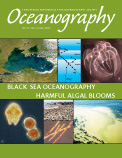First Paragraph
The Black Sea and the Bosporus Strait hold an important place in the history of oceanography. In 1680, the impressive geographical features and remarkable current patterns of the Bosporus sparked the imagination of young Luigi Ferdinando Marsigli to solve the long-standing puzzle of two-layer flow. The observations and experiments were published in the 1681 book by Marsigli, originally published in Italian, Observations around the Bosporus Strait or True Canal of Constantinople, Presented in a letter to Her Sacred Royal Majesty Queen Christina of Sweden by Luigi Ferdinando Marsigli. (This book was recently translated into English by the authors of this article.) Marsigli understood that the Bosporus currents were a simple consequence of the different water densities in the Black and Mediterranean Seas. He demonstrated this density difference by building a physical model that captured the salient features of the phenomenon (Figure 1). Marsigli made a two-compartment box with the divider connected by two openings at top and bottom, and showed that waters of different densities in the two compartments would flow to the opposite side in a manner consistent with his observations. British scientists had long suspected that two-layer flow was occurring in places like the Strait of Gibraltar and the Skagerack, but at the time, no one had managed to convincingly demonstrate the existence of an undercurrent, nor had anyone put forth a convincing explanation for it.

